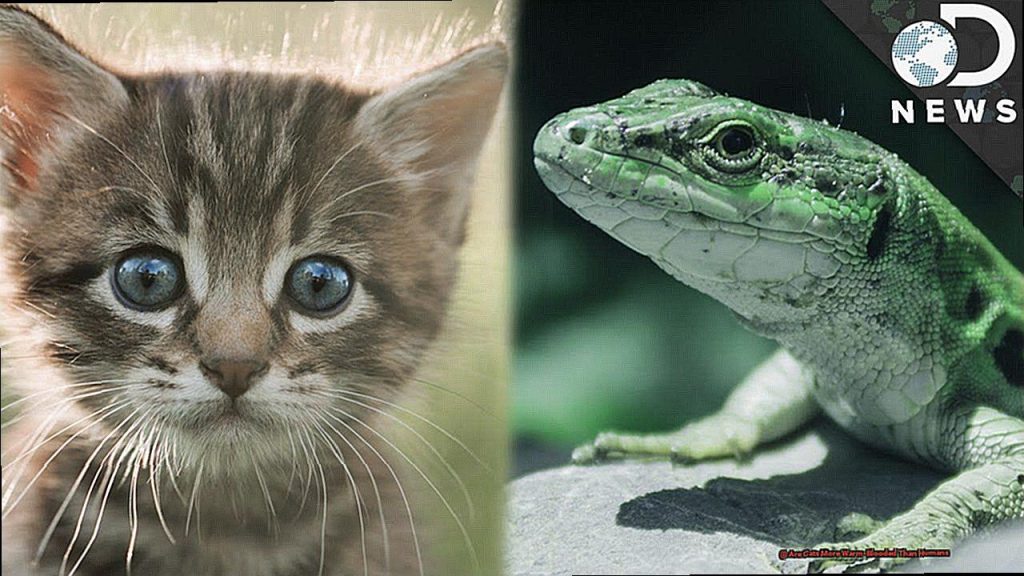Today’s blog post is all about our beloved feline friends and their warm-blooded nature. We all know that cats hold a special place in our hearts, but have you ever wondered about the biological differences between these purring creatures and us humans?
Specifically, their ability to regulate their body temperature despite changes in their surroundings. So let’s grab a cup of coffee (or tea, if you’re feeling fancy) and delve into the fascinating world of cats’ warm-bloodedness.
Get ready to discover what makes these fluffballs truly unique in the animal kingdom.
Are Cats More Warm-Blooded Than Humans?
Contents
The short answer is yes, but let’s delve deeper into the factors that contribute to this difference.
Body Temperature Comparison:
The average body temperature for a human is around 98.6°F (37°C), while cats have an average body temperature of 100.5°F (38°C). While this may seem like a significant difference, it falls within the normal range for both species.
Metabolism:
One reason for the slightly higher body temperature in cats may be due to their metabolism. Cats have a high metabolic rate, meaning they convert food into energy at a faster rate than humans. This results in more heat being produced, leading to a higher body temperature.
Fur Coat:
Another factor that contributes to cats being more warm-blooded than humans is their fur coat. Cats have thick, insulating fur that helps them retain heat and regulate their body temperature. In contrast, humans have much less hair on their bodies and rely on clothing to keep warm.
Resting Heart Rate:
Cats also have a higher resting heart rate than humans, which can help them generate more body heat. A cat’s resting heart rate can range from 120-140 beats per minute, while a human’s is typically between 60-100 beats per minute.
Unique Adaptations:
Interestingly, cats have a unique ability to raise their body temperature even further when needed. They do this by shivering their muscles, which generates heat and helps them stay warm in colder temperatures.
Being more warm-blooded than humans also means that cats are better adapted to survive in colder climates. Their higher body temperature allows them to thrive in colder environments without needing additional sources of warmth.
However, this does not mean that cats are invincible to extreme temperatures. Like humans, they can suffer from hypothermia or hyperthermia if exposed to extreme cold or heat for extended periods.
Optimal Body Temperature:
While cats may have a higher body temperature than humans, it does not necessarily mean they are healthier. Each species has its own optimal body temperature range, and as long as an animal falls within that range, they are considered healthy.
The Differences in Body Temperature
As cat owners, we all know that our feline friends have a higher body temperature than us humans. But have you ever wondered why?
In this post, we’ll explore the fascinating differences between cats and humans when it comes to their body temperatures, and how they are adapted to thrive in different environments.
Metabolic Rates: Why Cats Run Hotter

One of the main reasons for the difference in body temperature between cats and humans is their metabolic rates.
Cats have a faster metabolism than humans, meaning they produce more heat and use up more energy to maintain their body temperature.
This is due to their natural hunting instincts and need for energy to chase and catch prey. So next time your cat is zooming around the house, know that it’s just their high metabolism at work.
Fur Coats: The Ultimate Insulator
Another factor contributing to the higher body temperature of cats is their thick fur coat. This coat not only provides them with insulation from the cold, but it also helps retain heat in their bodies. This is especially important for outdoor cats who may be exposed to colder temperatures. So while we humans may rely on layers of clothing to keep us warm, our feline friends have their natural fur coat to thank.
Tolerance for Heat: Desert Dwellers
While humans may start feeling uncomfortable in temperatures above 80 degrees Fahrenheit, cats can tolerate much higher temperatures without breaking a sweat – or rather, without panting. This is due to their desert-dwelling ancestors who had to adapt to hot climates. In fact, cats can handle temperatures up to 126 degrees Fahrenheit without any issues. However, this doesn’t mean that they are immune to overheating, and it’s important for pet owners to monitor their cat’s body temperature and provide them with a cool place to rest if needed.
Maintaining Optimal Body Temperature
Just like us humans, cats need to maintain an optimal body temperature to stay healthy. While their higher body temperature is natural for them, it’s still important to monitor them for any signs of overheating.
If your cat starts panting excessively, drooling, or seems lethargic in hot weather, it’s best to provide them with a cool place to rest and plenty of fresh water to drink.

How Cats Conserve Energy with a Higher Baseline Temperature
Cats have a higher baseline body temperature compared to humans, ranging from 100.5°F to 102.5°F, while our average body temperature is 98.6°F. But have you ever wondered why this is? As a cat expert, I’m here to shed some light on this interesting feline characteristic and explain how it helps them conserve energy.
Thick Fur Coats for Insulation
One of the main reasons cats have a higher baseline temperature is their thick fur coats. This not only makes them incredibly soft to pet, but it also acts as insulation to help retain heat. In colder climates, this is essential for keeping cats warm and comfortable without relying on external sources of warmth. However, in warmer climates, cats may shed more as they don’t need as much insulation.
Lower Surface Area-to-Body-Mass Ratio
You may have noticed that cats have a relatively small surface area compared to their body mass. This means that they lose less heat through their skin, making it easier for them to maintain their higher baseline temperature without expending too much energy. This is especially beneficial for outdoor cats who may not have access to warm shelter during colder months.
Efficient Body Temperature Regulation
Cats are masters at regulating their body temperature. They have specialized muscles that allow them to shiver and generate heat when they get cold, and they can also pant or sweat through their paw pads to cool down when they get too hot. This efficient temperature regulation helps them conserve energy and maintain their optimal body temperature without relying on external sources of warmth.
What Does This Mean for Cat Owners?
As a cat owner, it’s important to understand your feline friend’s unique biology and how it affects their needs. While their higher baseline temperature allows them to conserve energy, it also means that they are more susceptible to heatstroke in hot environments.
So, be sure to provide your cat with plenty of water and a cool place to relax during hot days. And never leave them in a hot car or exposed to direct sunlight for extended periods.
Human’s Larger Surface Area and Need for Clothing to Regulate Temperature
As humans, we have all experienced the discomfort of being too hot or too cold. Our bodies are constantly working to maintain a stable internal temperature, and this becomes even more challenging when we are exposed to extreme temperatures.
But have you ever wondered why we need clothing to help regulate our body temperature, while our feline friends seem to do just fine without it? In this post, we’ll dive into the science behind humans’ larger surface area and their need for clothing to stay comfortable in varying environmental conditions.
Humans’ Larger Surface Area: The Challenge of Temperature Regulation
Compared to cats, humans have a larger surface area relative to their body mass. This means that we have more skin exposed to the environment, making it more challenging for us to maintain a stable body temperature. While cats have thick fur coats that act as insulation, humans have evolved to lose most of our body hair. This makes us more dependent on clothing for insulation and protection from external temperature changes.
Clothing: An Additional Layer of Insulation for Humans
Clothing provides an additional layer of insulation for humans, allowing us to maintain a stable body temperature in varying environmental conditions. However, this also means that we are less adapted to extreme temperatures and rely heavily on external factors for temperature regulation. In contrast, cats have natural adaptations that allow them to regulate their body temperature through behaviors like grooming and changing their position in the sun or shade.
Geographical Location and Activity Level: Factors in Clothing Needs
The need for clothing also varies among different human populations depending on their geographical location. Those living in colder climates require heavier and thicker clothing compared to those living in warmer regions. Additionally, our activity level also plays a role in our clothing needs. Humans who engage in physical activities generate more heat in their bodies and may need to remove layers of clothing to maintain a comfortable body temperature. Cats, on the other hand, have a lower activity level compared to humans and may need additional warmth during colder months.
Insulation and Heat Retention: The Role of Fur Coats in Cats
If you’re a cat owner, you may have noticed that your feline friend never seems to get cold, no matter how low the temperature drops. While we humans bundle up in layers of clothing to stay warm, our cats seem perfectly content lounging around with nothing but their fur coats. So what’s their secret? How do they stay so warm without any extra layers?
The answer lies in their fur coat. Cats have evolved to have thick, double-layered fur coats that provide excellent insulation against cold temperatures. Let’s take a closer look at how this works.
Layers of Protection
- A cat’s fur coat is made up of two layers: the longer guard hairs on the outer layer and the shorter, denser undercoat. This double-layered coat serves as a natural insulator, trapping heat close to the cat’s body and keeping them warm in colder climates. The undercoat, in particular, is made up of fine, soft hairs that are packed tightly together to create a layer of air pockets. These pockets act as a barrier against the cold air, preventing it from reaching the cat’s skin and keeping them warm and cozy.
Thick and Fluffy: Not Just for Looks
The thickness and density of a cat’s fur coat can vary depending on their breed. Long-haired breeds like Persians have more insulation than short-haired breeds like Siamese. This is why you may see long-haired cats in colder climates and short-haired cats in warmer ones. But regardless of breed, all cats have thick fur coats that provide them with warmth and protection.
In contrast, us humans do not have a thick fur coat to keep us warm. Instead, we rely on other methods such as clothing and shelter to regulate our body temperature. Our larger surface area also plays a role in our need for extra protection against the cold.
But fur is not the only thing that helps cats stay warm. They also have a special type of fat called brown adipose tissue, which helps them generate heat in colder temperatures. This type of fat is found in higher amounts in cats compared to humans, further contributing to their ability to retain heat.
Metabolism: A Key Factor in Body Temperature Regulation
As cat owners, we all know that our feline friends are masters of comfort. Whether it’s curling up in a warm sunbeam or snuggling under a blanket, they always seem to find the coziest spot in the house. But have you ever wondered how they manage to stay warm in colder temperatures without the luxury of a heated home? The answer lies in their metabolism.
What is Metabolism and How Does it Work?
Metabolism is the process by which the body converts food into energy. This energy is used for various bodily functions, including maintaining a constant internal temperature. Cats and humans are both endothermic animals, meaning we can generate our own body heat to stay warm.
However, cats have a higher resting metabolic rate (RMR) than humans. This means they burn more energy at rest, allowing them to generate more body heat and maintain a higher internal temperature. In fact, cats have a higher muscle mass compared to humans, which contributes to their faster metabolism.
Thermal Neutral Zone: Cats vs Humans
Another factor that plays a crucial role in regulating body temperature is the thermal neutral zone (TNZ). This is the range of environmental temperatures in which an animal can maintain its body temperature without expending extra energy. Cats have a higher TNZ than humans, meaning they can tolerate colder temperatures without needing to increase their metabolic rate.
But why do cats have a higher TNZ? It’s all about surface area-to-volume ratio. Cats have a smaller surface area compared to their body volume, which means they lose heat more slowly. In contrast, humans have a larger surface area-to-volume ratio and lose heat more quickly. This is why we tend to feel colder in the same environmental conditions as cats.
Surviving Extreme Temperatures
In extreme temperatures, both cats and humans have mechanisms to regulate their body temperature. We shiver in cold environments to generate heat, while cats have a unique adaptation called thermogenic brown fat. This type of fat helps them generate heat by burning fat reserves, allowing them to survive in colder climates without relying solely on their metabolism or external sources of heat.
On the other hand, in hot environments, humans sweat and cats pant to release excess body heat. This is why you may see your cat with an open mouth on a hot day – they are trying to cool down.
Unique Adaptations: Panting vs Sweating for Cooling Down
As the summer heat kicks in, many of us turn to sweating as a natural way to cool down. But what about our feline friends? Have you ever seen a cat pant like a dog? Probably not. That’s because cats have a unique adaptation that allows them to stay cool without panting or sweating – grooming.
Grooming is a behavior ingrained in all felines, from big cats like lions to your domestic house cat. It involves licking their fur to remove dirt and distribute natural oils that help regulate their body temperature. This constant grooming not only keeps their coat clean but also helps them cool down.
Unlike humans who have sweat glands all over their body, cats only have them on their paw pads. While these sweat glands do play a role in regulating body temperature, they are not as efficient as humans’ sweat glands. This means that cats rely more on grooming and seeking cooler areas to regulate their body temperature rather than sweating like humans do.
But why do cats have such a unique adaptation? Well, it may be due to their evolutionary history as desert animals. In the hot, dry environment of the desert, sweating would lead to dehydration and reduced chances of survival. So instead, cats have evolved to use grooming and seeking shade as their primary methods of cooling down.
Another factor that helps cats regulate their body temperature is their dense fur coat. Their fur acts as insulation, keeping them warm in colder temperatures and cooler in warmer temperatures. This is why you’ll often see cats seeking out warm spots in the winter and hiding in cool places during the summer.
Cats also have a higher resting heart rate compared to humans, typically ranging from 120-140 beats per minute. This fast heart rate helps them generate and maintain body heat. However, this can also be dangerous for cats in extreme temperatures because it increases the risk of dehydration. That’s why it’s crucial for cat owners to keep their feline friends hydrated and provide them with a cool environment during hot weather to prevent heatstroke.
Conclusion
In conclusion, we have delved into the captivating world of cats’ warm-bloodedness and their remarkable ability to regulate body temperature. Through our exploration, we have uncovered that cats are indeed more warm-blooded than humans, boasting a higher average body temperature, faster metabolism, and thicker fur coats. These distinctive characteristics allow them to thrive in colder environments without relying on external sources of warmth.
It is worth noting that each species has its own optimal body temperature range, and as long as an animal falls within that range, they are considered healthy. Therefore, while cats may have a higher baseline body temperature than humans, it does not necessarily equate to better health.
We have also unraveled the crucial role of metabolism and thermal neutral zone in regulating body temperature for both cats and humans. Due to their smaller surface area-to-volume ratio, cats can tolerate colder temperatures without needing to increase their metabolic rate. And in extreme temperatures, both species possess unique adaptations – shivering for humans and thermogenic brown fat for cats – to survive.
Let us not overlook the significance of our feline friends’ grooming behavior in keeping them cool during hot weather. While we humans rely on sweating to release excess body heat, cats use grooming and seeking shade as their primary methods of cooling down.
So, next time you catch your cat basking in the sun or snuggled under a blanket, remember that their warm-blooded nature is what sets them apart from other creatures in the animal kingdom.






